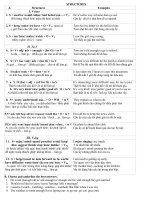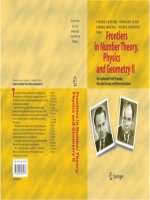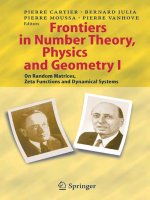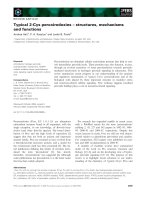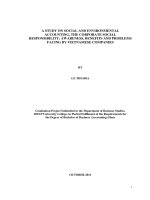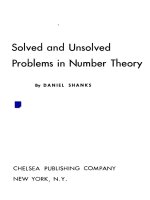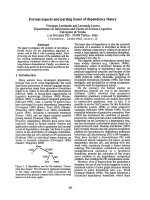Number theory structures, examples, and problems
Bạn đang xem bản rút gọn của tài liệu. Xem và tải ngay bản đầy đủ của tài liệu tại đây (2.32 MB, 415 trang )
i
”God made the integers, all else is the work of man.”
Leopold Kronecker
ii
NUMBER THEORY
Structures, Examples, and Problems
Titu Andreescu
Dorin Andrica
ii
Contents
Foreword
7
Acknowledgments
9
Notation
11
I STRUCTURES, EXAMPLES,
AND PROBLEMS
13
1 Divisibility
15
1.1
Divisibility . . . . . . . . . . . . . . . . . . . . . . . . . . .
15
1.2
Prime numbers . . . . . . . . . . . . . . . . . . . . . . . . .
21
1.3
The greatest common divisor . . . . . . . . . . . . . . . . .
30
1.4
Odd and even . . . . . . . . . . . . . . . . . . . . . . . . . .
39
1.5
Modular arithmetics . . . . . . . . . . . . . . . . . . . . . .
42
1.6
Chinese remainder theorem . . . . . . . . . . . . . . . . . .
47
1.7
Numerical systems . . . . . . . . . . . . . . . . . . . . . . .
50
1.7.1 Representation of integers in an arbitrary base . . .
50
1.7.2 Divisibility criteria in the decimal system . . . . . .
51
2
Contents
2 Powers of Integers
2.1 Perfect squares . . . . . . . . . . . . . . . . . . . . . . . . .
2.2 Perfect cubes . . . . . . . . . . . . . . . . . . . . . . . . . .
2.3 k th powers of integers, k ≥ 4 . . . . . . . . . . . . . . . . . .
61
61
70
72
3 Floor Function and Fractional Part
3.1 General problems . . . . . . . . . . . . . . . . . . . . . . . .
3.2 Floor function and integer points . . . . . . . . . . . . . . .
3.3 An useful result . . . . . . . . . . . . . . . . . . . . . . . . .
77
77
83
88
4 Digits of Numbers
91
4.1 The last digits of a number . . . . . . . . . . . . . . . . . . 91
4.2 The sum of the digits of a number . . . . . . . . . . . . . . 94
4.3 Other problems involving digits . . . . . . . . . . . . . . . . 100
5 Basic Principles in Number Theory
5.1 Two simple principles . . . . . . . .
5.1.1 Extremal arguments . . . . .
5.1.2 Pigeonhole principle . . . . .
5.2 Mathematical induction . . . . . . .
5.3 Infinite descent . . . . . . . . . . . .
5.4 Inclusion-exclusion . . . . . . . . . .
.
.
.
.
.
.
.
.
.
.
.
.
.
.
.
.
.
.
.
.
.
.
.
.
.
.
.
.
.
.
.
.
.
.
.
.
.
.
.
.
.
.
.
.
.
.
.
.
.
.
.
.
.
.
.
.
.
.
.
.
.
.
.
.
.
.
.
.
.
.
.
.
.
.
.
.
.
.
103
103
103
105
108
113
115
6 Arithmetic Functions
6.1 Multiplicative functions . . . . . . . . . . . .
6.2 Number of divisors . . . . . . . . . . . . . . .
6.3 Sum of divisors . . . . . . . . . . . . . . . . .
6.4 Euler’s totient function . . . . . . . . . . . . .
6.5 Exponent of a prime and Legendre’s formula
.
.
.
.
.
.
.
.
.
.
.
.
.
.
.
.
.
.
.
.
.
.
.
.
.
.
.
.
.
.
.
.
.
.
.
.
.
.
.
.
119
119
126
129
131
135
7 More on Divisibility
7.1 Fermat’s Little Theorem
7.2 Euler’s Theorem . . . .
7.3 The order of an element
7.4 Wilson’s Theorem . . .
.
.
.
.
.
.
.
.
.
.
.
.
.
.
.
.
.
.
.
.
.
.
.
.
.
.
.
.
.
.
.
.
141
141
147
150
153
.
.
.
.
.
.
.
.
.
.
.
.
.
.
.
.
.
.
.
.
.
.
.
.
.
.
.
.
.
.
.
.
.
.
.
.
.
.
.
.
.
.
.
.
.
.
.
.
8 Diophantine Equations
157
8.1 Linear Diophantine equations . . . . . . . . . . . . . . . . . 157
8.2 Quadratic Diophantine equations . . . . . . . . . . . . . . . 161
Contents
.
.
.
.
.
.
.
.
.
.
.
.
.
.
.
.
.
.
.
.
.
.
.
.
.
.
.
.
.
.
.
.
.
.
.
.
.
.
.
.
.
.
161
164
169
171
171
173
176
9 Some special problems in number theory
9.1 Quadratic residues. Legendre’s symbol . . . . . . .
9.2 Special numbers . . . . . . . . . . . . . . . . . . .
9.2.1 Fermat’s numbers . . . . . . . . . . . . . . .
9.2.2 Mersenne’s numbers . . . . . . . . . . . . .
9.2.3 Perfect numbers . . . . . . . . . . . . . . . .
9.3 Sequences of integers . . . . . . . . . . . . . . . . .
9.3.1 Fibonacci and Lucas sequences . . . . . . .
9.3.2 Problems involving linear recursive relations
9.3.3 Nonstandard sequences of integers . . . . .
.
.
.
.
.
.
.
.
.
.
.
.
.
.
.
.
.
.
.
.
.
.
.
.
.
.
.
.
.
.
.
.
.
.
.
.
.
.
.
.
.
.
.
.
.
179
179
188
188
191
192
193
193
197
204
8.3
8.2.1 Pythagorean equation . . . . . . .
8.2.2 Pell’s equation . . . . . . . . . . .
8.2.3 Other quadratic equations . . . . .
Nonstandard Diophantine equations . . .
8.3.1 Cubic equations . . . . . . . . . . .
8.3.2 High-order polynomial equations .
8.3.3 Exponential Diophantine equations
.
.
.
.
.
.
.
.
.
.
.
.
.
.
.
.
.
.
.
.
.
.
.
.
.
.
.
.
3
10 Problems Involving Binomial Coefficients
211
10.1 Binomial coefficients . . . . . . . . . . . . . . . . . . . . . . 211
10.2 Lucas’ and Kummer’s Theorems . . . . . . . . . . . . . . . 218
11 Miscellaneous Problems
II
223
SOLUTIONS TO PROPOSED PROBLEMS
12 Divisibility
12.1 Divisibility . . . . . . . . . .
12.2 Prime numbers . . . . . . . .
12.3 The greatest common divisor
12.4 Odd and even . . . . . . . . .
12.5 Modular arithmetics . . . . .
12.6 Chinese remainder theorem .
12.7 Numerical systems . . . . . .
.
.
.
.
.
.
.
.
.
.
.
.
.
.
.
.
.
.
.
.
.
.
.
.
.
.
.
.
.
.
.
.
.
.
.
.
.
.
.
.
.
.
.
.
.
.
.
.
.
.
.
.
.
.
.
.
.
.
.
.
.
.
.
.
.
.
.
.
.
.
.
.
.
.
.
.
.
.
.
.
.
.
.
.
.
.
.
.
.
.
.
.
.
.
.
.
.
.
.
.
.
.
.
.
.
229
.
.
.
.
.
.
.
.
.
.
.
.
.
.
231
231
237
242
247
248
251
253
13 Powers of Integers
261
13.1 Perfect squares . . . . . . . . . . . . . . . . . . . . . . . . . 261
4
Contents
13.2 Perfect cubes . . . . . . . . . . . . . . . . . . . . . . . . . . 270
13.3 k th powers of integers, k ≥ 4 . . . . . . . . . . . . . . . . . . 272
14 Floor Function and Fractional Part
275
14.1 General problems . . . . . . . . . . . . . . . . . . . . . . . . 275
14.2 Floor function and integer points . . . . . . . . . . . . . . . 279
14.3 An useful result . . . . . . . . . . . . . . . . . . . . . . . . . 280
15 Digits of Numbers
283
15.1 The last digits of a number . . . . . . . . . . . . . . . . . . 283
15.2 The sum of the digits of a number . . . . . . . . . . . . . . 284
15.3 Other problems involving digits . . . . . . . . . . . . . . . . 288
16 Basic Principles in Number
16.1 Two simple principles . .
16.2 Mathematical induction .
16.3 Infinite descent . . . . . .
16.4 Inclusion-exclusion . . . .
.
.
.
.
.
.
.
.
.
.
.
.
.
.
.
.
.
.
.
.
.
.
.
.
.
.
.
.
.
.
.
.
.
.
.
.
291
291
294
300
301
17 Arithmetic Functions
17.1 Multiplicative functions . . . . . . . . . . . .
17.2 Number of divisors . . . . . . . . . . . . . . .
17.3 Sum of divisors . . . . . . . . . . . . . . . . .
17.4 Euler’s totient function . . . . . . . . . . . . .
17.5 Exponent of a prime and Legendre’s formula
.
.
.
.
.
.
.
.
.
.
.
.
.
.
.
.
.
.
.
.
.
.
.
.
.
.
.
.
.
.
.
.
.
.
.
.
.
.
.
.
305
305
307
309
311
313
.
.
.
.
319
319
326
328
330
.
.
.
.
.
.
333
333
336
336
337
340
343
18 More on Divisibility
18.1 Fermat’s Little Theorem
18.2 Euler’s Theorem . . . .
18.3 The order of an element
18.4 Wilson’s Theorem . . .
.
.
.
.
Theory
. . . . . .
. . . . . .
. . . . . .
. . . . . .
.
.
.
.
.
.
.
.
.
.
.
.
.
.
.
.
.
.
.
.
.
.
.
.
19 Diophantine Equations
19.1 Linear Diophantine equations . . . .
19.2 Quadratic Diophantine equations . .
19.2.1 Pythagorean equations . . .
19.2.2 Pell’s equation . . . . . . . .
19.2.3 Other quadratic equations .
19.3 Nonstandard Diophantine equations
.
.
.
.
.
.
.
.
.
.
.
.
.
.
.
.
.
.
.
.
.
.
.
.
.
.
.
.
.
.
.
.
.
.
.
.
.
.
.
.
.
.
.
.
.
.
.
.
.
.
.
.
.
.
.
.
.
.
.
.
.
.
.
.
.
.
.
.
.
.
.
.
.
.
.
.
.
.
.
.
.
.
.
.
.
.
.
.
.
.
.
.
.
.
.
.
.
.
.
.
.
.
.
.
.
.
.
.
.
.
.
.
.
.
.
.
.
.
.
.
.
.
.
.
.
.
.
.
.
.
.
.
.
.
.
.
Contents
5
19.3.1 Cubic equations . . . . . . . . . . . . . . . . . . . . 343
19.3.2 High-order polynomial equations . . . . . . . . . . . 345
19.3.3 Exponential Diophantine equations . . . . . . . . . 347
20 Some special problems in number theory
20.1 Quadratic residues. Legendre’s symbol . . . . . . . .
20.2 Special numbers . . . . . . . . . . . . . . . . . . . .
20.2.1 Fermat’s numbers . . . . . . . . . . . . . . .
20.2.2 Mersenne’s numbers . . . . . . . . . . . . . .
20.2.3 Perfect numbers . . . . . . . . . . . . . . . .
20.3 Sequences of integers . . . . . . . . . . . . . . . . . .
20.3.1 Fibonacci and Lucas sequences . . . . . . . .
20.3.2 Problems involving linear recursive relations
20.3.3 Nonstandard sequences of integers . . . . . .
.
.
.
.
.
.
.
.
.
.
.
.
.
.
.
.
.
.
.
.
.
.
.
.
.
.
.
.
.
.
.
.
.
.
.
.
351
351
354
354
356
357
357
357
360
364
21 Problems Involving Binomial Coefficients
379
21.1 Binomial coefficients . . . . . . . . . . . . . . . . . . . . . . 379
21.2 Lucas’ and Kummer’s Theorems . . . . . . . . . . . . . . . 384
22 Miscellaneous Problems
387
Glossary
393
References
401
Index of Authors
407
Subject Index
409
6
Contents
Foreword
One of the oldest and liveliest branches of mathematics, Number Theory, is noted for its theoretical depth and applications to other fields, including representation theory, physics, and cryptography. The forefront of
Number Theory is replete with sophisticated and famous open problems;
at its foundation, however, are basic, elementary ideas that can stimulate
and challenge beginning students. This textbook takes a problem-solving
approach to Number Theory, situating each theoretical concept within
the framework of some examples or some problems for readers to solve.
Starting with the essentials, the text covers divisibility, powers of integers, floor function and fractional part, digits of numbers, basic methods
of proof (extremal arguments, pigeonhole principle, induction, infinite descent, inclusion-exclusion), arithmetic function, important divisibility theorems and Diophantine equations. Emphasis is also placed on the presentation of some special problems involving quadratic residues, Fermat,
Mersenne, and perfect numbers, as well as famous sequences of integers
such as Fibonacci, Lucas, and other important ones defined by recursive
relations. By thoroughly discussing interesting examples and applications
and by introducing and illustrating every key idea, by relevant problems of
various levels of difficulty, the book motivates, engages and challenges the
8
Foreword
reader. The exposition proceeds incrementally, intuitively and rigorously
uncovers deeper properties.
A special feature of the book is an outstanding selection of genuine
Olympiad and other important mathematical contest problems solved using the methods already presented. The book brings about the unique and
vast experience of the authors. It captures the spirit of an important mathematical literature and distills the essence of a rich problem-solving culture.
”Number Theory: Structures, Examples and Problems” will appeal to
senior high school and undergraduate students, their instructors, as well as
to all who would like to expand their mathematical horizons. It is a source
of fascinating problems for readers at all levels and widely opens the gate
to further explorations in mathematics.
Acknowledgments
Many problems are either inspired by or adapted from various mathematical contests in different countries. We express our deepest appreciation to
the original proposers of the problems. Special thanks are given to Gabriel
Dospinescu (Ecole Normale Superieure Paris, France) for the careful proof
reading of the manuscript and for many helpful suggestions.
10
Acknowledgments
Notation
Z
Zn
N
N0
Q
Q+
Q0
Qn
R
R+
R0
Rn
C
|A|
A⊂B
A⊆B
A\B
A∩B
A∪B
a∈A
the set of integers
the set of integers modulo n
the set of positive integers
the set of nonnegative integers
the set of rational numbers
the set of positive rational numbers
the set of nonnegative rational numbers
the set of n-tuples of rational numbers
the set of real numbers
the set of positive real numbers
the set of nonnegative real numbers
the set of n-tuples of real numbers
the set of complex numbers
the number of elements in the set A
A is a proper subset of B
A is a subset of B
A without B (set difference)
the intersection of sets A and B
the union of sets A and B
the element a belongs to the set A
12
Notation
n|m
gcd(m, n)
lcm(m, n)
π(n)
τ (n)
σ(n)
a ≡ b (mod m)
ϕ
ordm (a)
µ
ak ak−1 . . . a0 (b)
S(n)
(f1 , f2 , . . . , fm )
⌊x⌋
⌈x⌉
{x}
ep
pk n
fn
Mn
a
p
Fn
Ln
Pn
n
k
n divides m
the greatest common divisor of m, n
the least common multiple of m, n
the number of primes ≤ n
number of divisors of n
sum of positive divisors of n
a and b are congruent modulo m
Euler’s totient function
order of a modulo m
M¨obius function
base b representation
the sum of digits of n
factorial base expansion
floor of x
celling of x
fractional part of x
Legendre’s function
pk fully divides n
Fermat’s number
Mersenne’s number
Legendre’s symbol
Fibonacci’s number
Lucas’ number
Pell’s number
binomial coefficient
Part I
STRUCTURES,
EXAMPLES,
AND PROBLEMS
13
1
Divisibility
1.1 Divisibility
For integers a and b, a = 0, we say that a divides b if b = ac for some
integer c. We denote this by a|b. We also say that b is divisible by a or that
b is a multiple of a.
Because 0 = a · 0, it follows that a|0 for all integers a, a = 0.
Straight from the definition we can derive the following properties:
1. If a|b, b = 0, then |a| ≤ |b|;
2. If a|b and a|c, then a|αb + βc for any integers α and β;
3. If a|b and a|b ± c, then a|c;
4. a|a (reflexivity);
5. If a|b and b|c, then a|c (transitivity);
6. If a|b and b|a, then |a| = |b|.
The following result is called the Division Algorithm and it plays an
important role:
Theorem. For any positive integers a and b there exists a unique pair
(q, r) of nonnegative integers such that
b = aq + r,
r < a.
Proof. If a > b, then q = 0 and r = b < a.
16
1. DIVISIBILITY
If a = b, then q = 1 and r = 0 < a.
If a < b, then there exist positive integers n such that na > b. Let q be
the least positive integer for which (q+1)a > b. Then qa ≤ b. Let r = b−aq.
It follows that b = aq + r and 0 ≤ r < a.
For the uniqueness, assume that b = aq ′ + r′ , where q ′ and r′ are also
nonnegative integers satisfying 0 ≤ r′ < a. Then aq + r = aq ′ + r′ , implying
a(q − q ′ ) = r′ − r, and so a|r′ − r. Hence |r′ − r| ≥ a or |r′ − r| = 0. Because
0 ≤ r, r′ < a yields |r′ − r| < a, we are left with |r′ − r| = 0, implying
r′ = r and, consequently, q ′ = q.
In the theorem above, when a is divided by b, q is called the quotient
and r the remainder.
Remark. The Division Algorithm can be extended for integers as follows: For any integers a and b, a = 0, there exists a unique pair (q, r) of
integers such that
b = aq + r, 0 ≤ r < |a|.
Example. Prove that for all positive integers n, the fraction
21n + 4
14n + 3
is irreducible.
(1st IMO)
Indeed, from the equality
2(21n + 4) − 3(14n + 3) = −1
it follows that 21n + 4 and 14n + 3 have no common divisor except for 1,
hence the conclusion.
Problem 1.1.1. Prove that for all integers n:
a) n5 − 5n3 + 4n is divisible by 120;
b) n2 + 3n + 5 is not divisible by 121.
Solution. a) n5 − 5n3 + 4n = n(n2 − 1)(n2 − 4)
= n(n − 1)(n + 1)(n − 2)(n + 2),
the product of five consecutive integers: n − 2, n − 1, n, n + 1, n + 2.
If n ∈ {−2, −1, 0, 1, 2} we get n5 − 5n3 + 4n = 0 and the property holds.
If n ≥ 3 we can write
n5 − 5n3 + 4n = 5!
n+2
5
= 120
n+2
,
5
1.1. DIVISIBILITY
17
and the conclusion follows.
If n ≤ −3, write n = −m, where m ≥ 3, and obtain
n5 − 5n3 + 4n = −120
m+2
,
5
and we are done.
b) Observe that
n2 + 3n + 5 = (n + 7)(n − 4) + 33,
so that 11|n2 +3n+5 if and only if 11|(n+7)(n−4). Thus, if 11 ∤ (n+7)(n−4)
then 11 (and hence 121) does not divide n2 + 3n + 5. So, assume 11 divides
(n + 7)(n − 4). Then 11|n + 7 or 11|n − 4; but then 11 must divide both
of n + 7 and n − 4, since (n + 7) − (n − 4) = 11. Thus, 121|(n + 7)(n − 4).
However, 121 ∤ 33. So 121 ∤ n2 + 3n + 5 = (n + 7)(n − 4) + 33. Hence, in all
cases, 121 ∤ n2 + 3n + 5.
Problem 1.1.2. Let p > 2 be an odd number and let n be a positive
n
n
n
integer. Prove that p divides 1p + 2p + · · · + (p − 1)p .
Solution. Define k = pn and note that k is odd. Then
dk + (p − d)k = p[dk−1 − dk−2 (p − d) + · · · + (p − d)k−1 ]
Summing up the equalities from d = 1 to d =
1k + 2k + · · · + (p − 1)k , as claimed.
Problem 1.1.3. Prove that
5
p−1
implies that p divides
2
6
34 + 45
is a product of two integers, each of which is larger than 102002 .
1
4
Solution. The given number is of the form m4 + n4 , where m = 34
4
and
n=4
56 +1
4
=2
56 +1
2
.
The conclusion follows from the identity
m4 +
n4
1
= m4 + m2 n 2 + n 4 − m2 n 2 =
4
4
=
1
m2 + mn + n2
2
1
m2 + n 2
2
1
m2 − mn + n2 ,
2
2
− m2 n 2 =
18
1. DIVISIBILITY
n2
is an integer, and from the inequalities:
2
where n is even so
1
n
m2 − mn + n2 = m −
2
2
6
= 25
−1
2
+
n2
n2
>
4
4
> 210008 > (24 )2002 > 102002 .
Problem 1.1.4. Find all positive integers n such that for all odd integers
a, if a2 ≤ n then a|n.
Solution. Let a be the greatest odd integer such that a2 < n, hence
n ≤ (a + 2)2 . If a ≥ 7, then a − 4, a − 2, a are odd integers which divide n.
Note that any two of these numbers are relatively prime, so (a − 4)(a − 2)a
divides n. It follows that (a − 4)(a − 2)a ≤ (a + 2)2 so a3 − 6a2 + 8a ≤
a2 + 4a + 4. Then a3 − 7a2 + 4a − 4 ≤ 0 or a2 (a − 7) + 4(a − 1) ≤ 0. This
is false, because a ≥ 7, hence a = 1, 3 or 5.
If a = 1, then 12 ≤ n ≤ 32 , so n ∈ {1, 2, . . . , 8}.
If a = 3, then 32 ≤ n ≤ 52 and 1 · 3|n, so n ∈ {9, 12, 15, 18, 21, 24}.
If a = 5, then 52 ≤ n ≤ 72 and 1 · 3 · 5|n so n ∈ {30, 45}. Therefore
n ∈ {1, 2, 3, 4, 5, 6, 7, 8, 9, 12, 15, 18, 21, 24, 30, 45}.
Problem 1.1.5. Find the elements of the set
S=
Solution. Since
x ∈ Z|
x3 − 3x + 2
∈Z .
2x + 1
x3 − 3x + 2
∈ Z, then
2x + 1
8x3 − 24x + 16
27
= 4x2 − 2x − 11 +
∈ Z.
2x + 1
2x + 1
It follows that 2x + 1 divides 27, so
2x + 1 ∈ {±1, ±3, ±9, ±27} and x ∈ {−14, −5, −2, −1, 0, 1, 4, 13},
since 2x + 1 is odd,
x3 − 3x + 2
8x3 − 24x + 16
∈Z ⇔
∈ Z, so all these
2x + 1
2x + 1
are solutions.
Problem 1.1.6. Find all positive integers n for which the number obtained by erasing the last digit is a divisor of n.
Solution. Let b be the last digit of the number n and let a be the number
obtained from n by erasing the last digit b. Then n = 10a + b. Since a is
a divisor of n, we infer that a divides b. Any number n that ends in 0 is
1.1. DIVISIBILITY
19
therefore a solution. If b = 0, then a is a digit and n is one of the numbers
11, 12,. . . , 19, 22, 24, 26, 28, 33, 36, 39, 44, 48, 55, 56, 77, 88 or 99.
Problem 1.1.7. Find the greatest positive integer x such that 236+x
divides 2000!.
Solution. The number 23 is prime and divides every 23rd number. In
2000
= 86 numbers from 1 to 2000 that are divisible by
all, there are
23
23. Among those 86 numbers, three of them, namely 23, 2 · 23 and 3 · 232
are divisible by 233 . Hence 2389 |2000! and x = 89 − 6 = 83.
Problem 1.1.8. Find the positive integers n with exactly 12 divisors
1 = d1 < d2 < · · · < d12 = n such that the divisor with index d4 (that is,
dd4 − 1) is (d1 + d2 + d4 )d8 .
(1989 Russian Mathematical Olympiad)
Solution. Of course, there is 1 ≤ i ≤ 12 such that di = d1 +d2 +d4 . Since
di > d4 , we have i ≥ 5. Also, observe that dj d13−j = m for all j and since
di d8 = dd4 −1 ≤ n, we must have i ≤ 5, thus i = 5 and d1 + d2 + d4 = d5 .
Also, dd4 −1 = d5 d8 = n = d12 , thus d4 = 13 and d5 = 14 + d2 . Of course,
d2 is the smallest prime divisor of n and since d4 = 13, we can only have
d2 ∈ {2, 3, 5, 7, 11}. Also, since n has 12 divisors, it has at most 3 prime
divisors. If d2 = 2 then d5 = 16 and then 4 and 8 are divisors of n, smaller
than d4 = 13, impossible. A similar argument shows that d2 = 3 and
d5 = 17. Since n has 12 divisors and is a multiple of 3 · 13 · 17, the only
possibilities are 9 · 13 · 17, 3 · 1697 or 3 · 13 · 289. One can easily check that
only 9 · 13 · 17 = 1989 is a solution.
Problem 1.1.9. Let n be a positive integer. Show that any number
greater than n4 /16 can be written in at most one way as the product of
two of its divisors having difference not exceeding n.
(1998 St. Petersburg City Mathematical Olympiad)
First Solution. Suppose, on the contrary, that there exist a > c ≥ d > b
with a − b ≤ n and ab = cd > n4 /16. Put p = a + b, q = a − b, r = c + d,
s = c − d. Now
p2 − q 2 = 4ab = 4cd = r2 − s2 > n4 /4.
Thus p2 − r2 = q 2 − s2 ≤ q 2 ≤ n2 . But r2 > n4 /4 (so r > n2 /2) and p > r,
so
p2 − r2 > (n2 /2 + 1)2 − (n2 /2)2 ≥ n2 + 1,
20
1. DIVISIBILITY
a contradiction.
Second solution. Again, suppose that ab = cd > n4 /16, with a > c, d
and n ≥ a − b. If we let p = gcd(a, c), we can find positive integers p, q, r, s
such that a = pq, b = rs, c = pr, d = qs. Then a > c ⇒ q > r and
a > d ⇒ p > s, so that
n ≥ pq − rs
≥ (s + 1)(r + 1) − rs
=r+s+1
√
≥ 2 b + 1.
2
n−1
n−1
< n2 /4, and a ≤
2
2
2
2
n −1
Therefore ab ≤
< n4 /16, a contradiction.
4
2
Thus b ≤
+n =
n+1
2
2
.
Proposed problems
Problem 1.1.10. Show that for any natural number n, between n2 and
(n + 1)2 one can find three distinct natural numbers a, b, c such that a2 + b2
is divisible by c.
(1998 St. Petersburg City Mathematical Olympiad)
Problem 1.1.11. Find all odd positive integers n greater than 1 such
that for any relatively prime divisors a and b of n, the number a + b − 1 is
also a divisor of n.
(2001 Russian Mathematical Olympiad)
Problem 1.1.12. Find all positive integers n such that 3n−1 + 5n−1
divides 3n + 5n .
(1996 St. Petersburg City Mathematical Olympiad)
Problem 1.1.13. Find all positive integers n such that the set
{n, n + 1, n + 2, n + 3, n + 4, n + 5}
can be split into two disjoint subsets such that the products of elements in
these subsets are the same.
(12th IMO)
